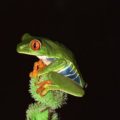
When species become asexual they could be taking the first step to extinction, say researchers from Imperial College London. They’ve been studying the genetic structure of Penicillium marneffei, an asexual fungus only found in parts of south-east Asia. Their research, appearing in PLoS Pathogens, found that although P. marneffei spores were able to spread over large distances on currents of air, they were not able to ‘invade’ the new environments in which they landed.
“We believe the failure of P. marneffei to adapt to new environments is because the fungus has largely dispensed with sexual reproduction. Without sex, you will not have the mixing of genes it causes, something all organisms need in order to be able to adapt to new environments,” said researcher Mat Fisher. Evolutionary theory predicts that while asexual organisms can initially prosper and out-compete their sexual cousins, they pay a price for being unable to adapt through the recombination of genes caused by sexual reproduction.
“By being asexual, P. marneffei is not only limiting its ability to adapt, it may be at risk of becoming extinct. If it is unable to adapt to new environments, it will be unable to adapt to changes in its current environment. While becoming asexual may provide short term advantages to a species, in the long term, they are likely to end up in evolution’s ultimate dustbin – extinction,” concluded co-researcher Bill Hanage.


















Comments are closed.